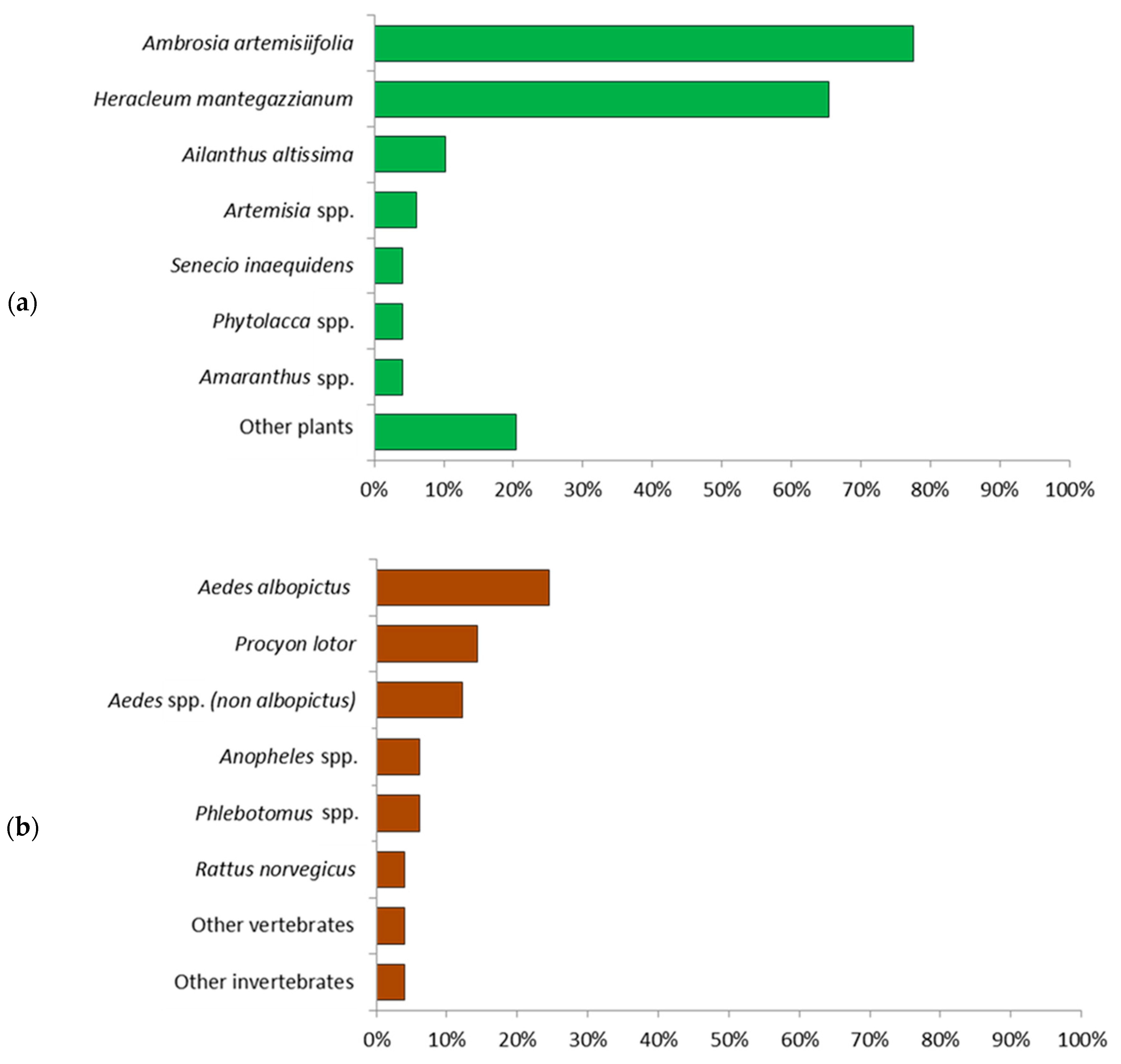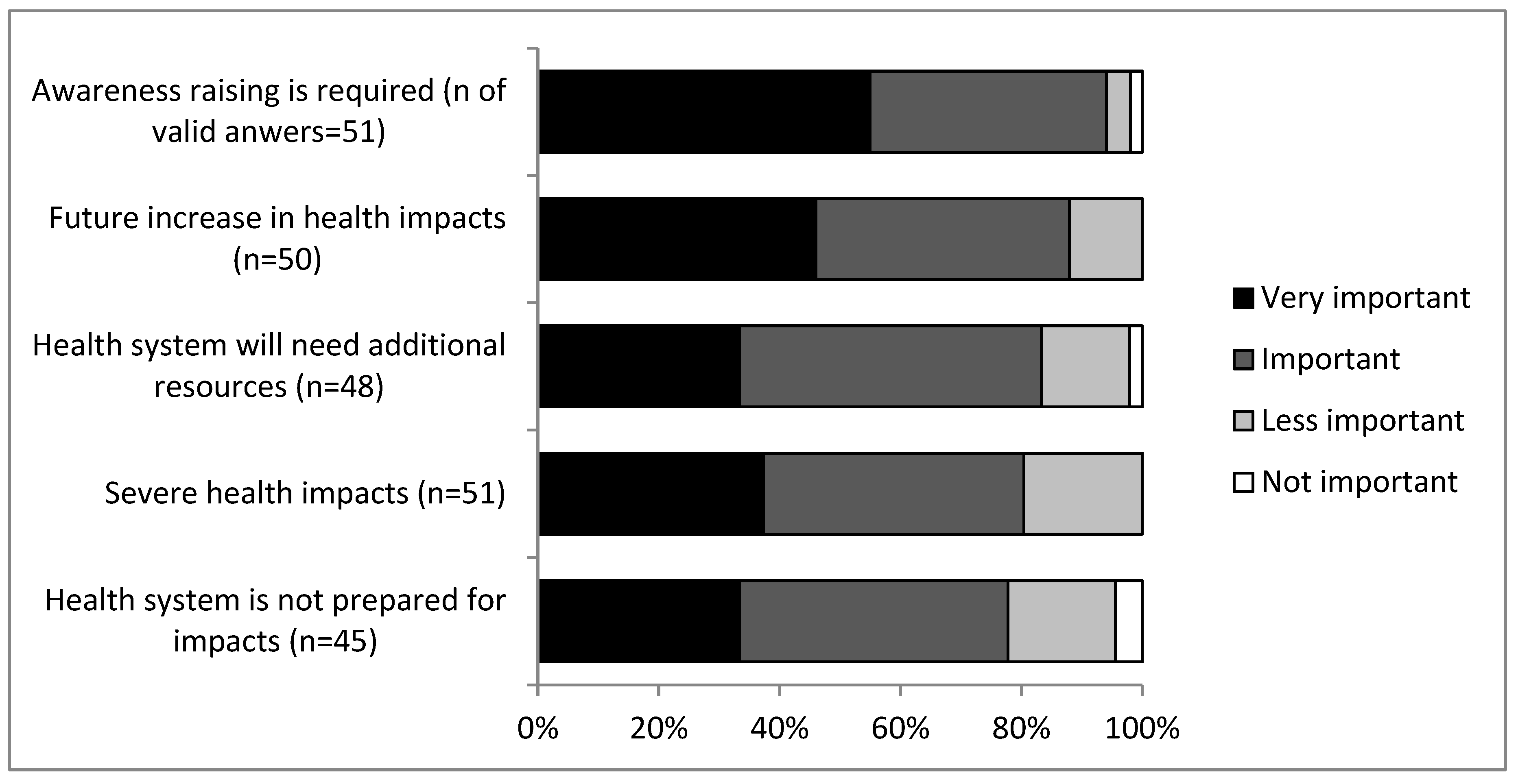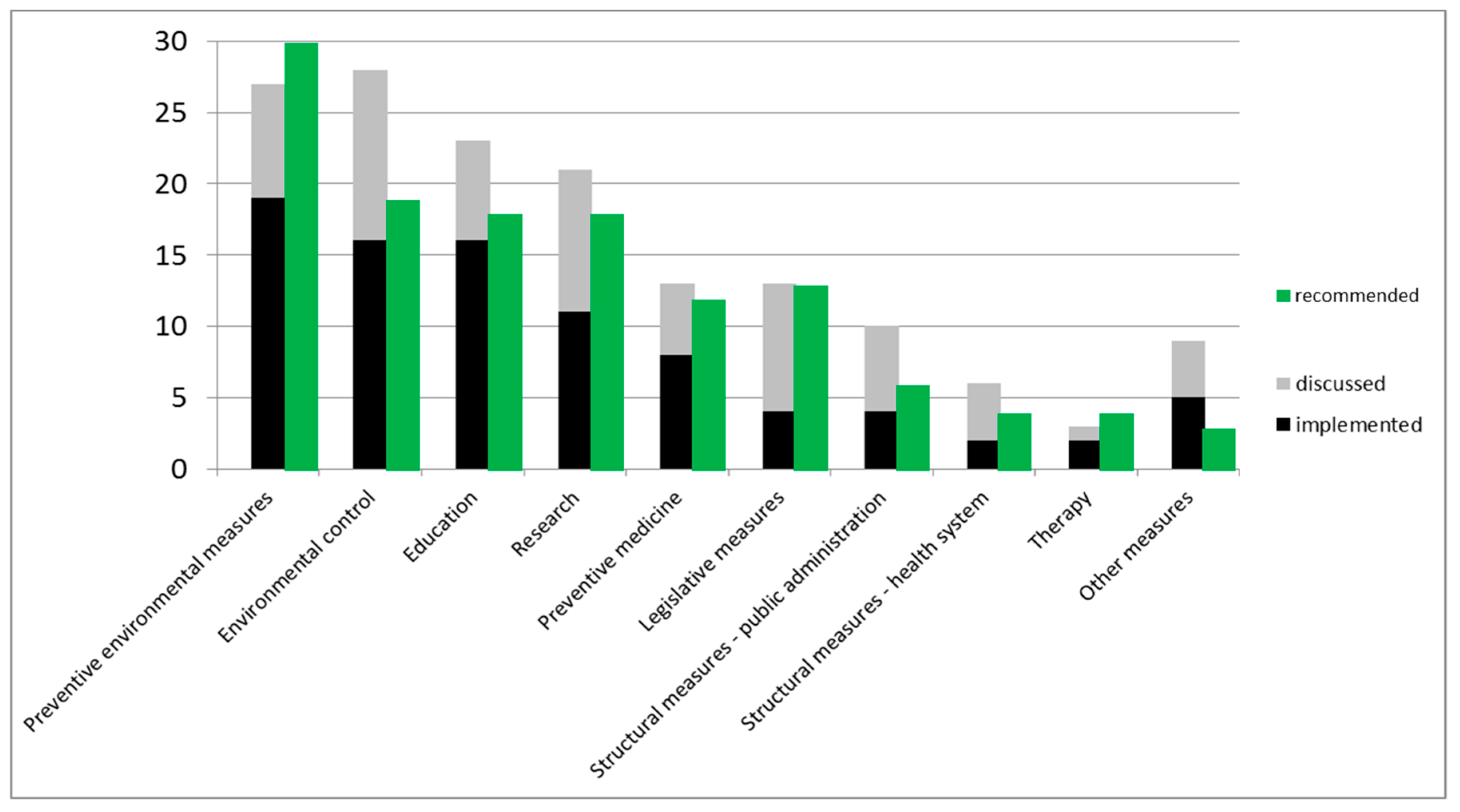Alien Species and Human Health: Austrian Stakeholder Perspective on Challenges and Solutions
Abstract
1. Introduction
2. Methods
2.1. Online Questionnaire
2.2. In-Depth Interviews
3. Results
3.1. Online Questionnaire
3.2. In Depth Interviews
4. Discussion
5. Conclusions and Recommendations
Supplementary Materials
Author Contributions
Funding
Acknowledgments
Conflicts of Interest
References
- Vilà, M.; Basnou, C.; Pyšek, P.; Josefsson, M.; Genovesi, P.; Gollasch, S.; Nentwig, W.; Olenin, S.; Roques, A.; Roy, D.; et al. How well do we understand the impacts of alien species on ecosystem services? A pan-European, cross-taxa assessment. Front. Ecol. Environ. 2010, 8, 135–144. [Google Scholar] [CrossRef]
- Vilà, M.; Espinar, J.L.; Hejda, M.; Hulme, P.E.; Jarošík, V.; Maron, J.L.; Pergl, J.; Schaffner, U.; Sun, Y.; Pyšek, P. Ecological impacts of invasive alien plants: A meta-analysis of their effects on species, communities and ecosystems. Ecol. Lett. 2011, 14, 702–708. [Google Scholar] [CrossRef] [PubMed]
- Bullock, J.; Chapman, D.; Schafer, S.; Roy, D.; Girardello, M.; Haynes, T.; Beale, S.; Wheeler, B.; Dickie, I.; Phang, Z.; et al. Final Report: ENV.B.2/ETU/2010/0037: Assessing and Controlling the Spread and the Effects of Common Ragweed in Europe). Available online: http://ec.europa.eu/environment/nature/invasivealien/docs/Final_Final_Report.pdf (accessed on 12 November 2018).
- Vila, M.; Hulme, P.E. Impact of Biological Invasions on Ecosystem Services; Springer: Cham, Switzerland, 2017; ISBN 978-3-319-45119-0. [Google Scholar]
- Roy, H.; Rabitsch, W.; Scalera, R.; Stewart, A.; Gallardo, B.; Genovesi, P.; Essl, F.; Adriaens, T.; Bacher, S.; Booy, O.; et al. Developing a framework of minimum standards for the risk assessment of alien species. J. Appl. Ecol. 2018, 55, 526–538. [Google Scholar] [CrossRef]
- Tollington, S.; Turbé, A.; Rabitsch, W.; Groombridge, J.J.; Scalera, R.; Essl, F.; Shwartz, A. The EU legislation on invasive species can lead to conservation success. Conserv. Lett. 2017, 10, 112–120. [Google Scholar] [CrossRef]
- Seebens, H.; Blackburn, T.M.; Dyer, E.E.; Genovesi, P.; Hulme, P.E.; Jeschke, J.M.; Pagad, S.; Pysek, P.; Winter, M.; Arianoutsou, M.; et al. No saturation in the accumulation of alien species worldwide. Nat. Commun. 2017, 8, 14435. [Google Scholar] [CrossRef] [PubMed]
- Seebens, H.; Blackburn, T.M.; Dyer, E.E.; Genovesi, P.; Hulme, P.E.; Jeschke, J.M.; Pagad, S.; Pyšek, P.; van Kleunen, M.; Winter, M.; et al. Global rise in emerging alien species results from increased accessibility of new source pools. Proc. Natl. Acad. Sci. USA 2018, 115, E2264–E2273. [Google Scholar] [CrossRef] [PubMed]
- Walther, G.R.; Roques, A.; Hulme, P.E.; Sykes, M.T.; Pyšek, P.; Kühn, I.; Czucz, B. Alien species in a warmer world: Risks and opportunities. Trends Ecol. Evol. 2009, 24, 686–693. [Google Scholar] [CrossRef] [PubMed]
- Hulme, P.E. Climate change and biological invasions: Evidence, expectations, and response options. Biol. Rev. 2017, 92, 1297–1313. [Google Scholar] [CrossRef] [PubMed]
- Chytrý, M.; Maskell, L.C.; Pino, J.; Pyšek, P.; Vilà, M.; Font, X.; Smart, S.M. Habitat invasions by alien plants: A quantitative comparison among Mediterranean, subcontinental and oceanic regions of Europe. J. Appl. Ecol. 2008, 45, 448–458. [Google Scholar] [CrossRef]
- Spaak, P.; Fox, J.; Hairston, N.G. Modes and mechanisms of a Daphnia invasion. Proc. R. Soc. B Biol. Sci. 2012, 279, 2936–2944. [Google Scholar] [CrossRef] [PubMed]
- Hulme, P.E. Invasive species challenge the global response to emerging diseases. Trends Parasitol. 2014, 30, 267–270. [Google Scholar] [CrossRef] [PubMed]
- Mazza, G.; Tricarico, E.; Genovesi, P.; Gherardi, F. Biological invaders are threats to human health: An overview. Ethol. Ecol. Evol. 2014, 26, 112–129. [Google Scholar] [CrossRef]
- Mazza, G.; Tricarico, E. Invasive Species and Human Health; CABI: Wallingford, UK, 2018; ISBN 978-1-78639-098-1. [Google Scholar]
- Schindler, S.; Staska, B.; Adam, M.; Rabitsch, W.; Essl, F. Alien species and public health impacts in Europe: A literature review. NeoBiota 2015, 27, 1. [Google Scholar] [CrossRef]
- Richter, R.; Berger, U.E.; Dullinger, S.; Essl, F.; Leitner, M.; Smith, M.; Vogl, G. Spread of invasive ragweed: Climate change, management and how to reduce allergy costs. J. Appl. Ecol. 2013, 50, 1422–1430. [Google Scholar] [CrossRef]
- Rabitsch, W.; Essl, F.; Schindler, S. The rise of non-native vectors and reservoirs of human diseases. In Impact of Biological Invasions on Ecosystem Services; Springer: Cham, Switzerland, 2017; pp. 263–275. ISBN 978-3-319-45119-0. [Google Scholar]
- Duscher, G.G.; Leschnik, M.; Fuehrer, H.P.; Joachim, A. Wildlife reservoirs for vector-borne canine, feline and zoonotic infections in Austria. Int. J. Parasitol. Parasites Wildl. 2015, 4, 88–96. [Google Scholar] [CrossRef] [PubMed]
- Bayliss, H.R.; Schindler, S.; Essl, F.; Rabitsch, W.; Pullin, A.S. What evidence exists for changes in the occurrence, frequency or severity of human health impacts resulting from exposure to alien invasive species in Europe? A systematic map protocol. Environ. Evid. 2015, 4, 10. [Google Scholar] [CrossRef]
- Bayliss, H.R.; Schindler, S.; Adam, M.; Essl, F.; Rabitsch, W. Evidence for changes in the occurrence, frequency or severity of human health impacts resulting from exposure to species alien to Europe: A systematic map. Environ. Evid. 2017, 6, 21. [Google Scholar] [CrossRef]
- Vaz, A.S.; Kueffer, C.; Kull, C.; Richardson, D.; Schindler, S.; Muñoz-Pajares, A.J.; Vicente, J.R.; Martins, J.; Hui, C.; Kühn, I.; et al. The progress of interdisciplinarity in invasion science. AMBIO 2017, 46, 428–442. [Google Scholar] [CrossRef] [PubMed]
- Schindler, S.; Zulka, K.-P.; Sonderegger, G.; Oberleitner, I.; Peterseil, J.; Essl, F.; Ellmauer, T.; Adam, M.; Stejskal-Tiefenbach, M. Entwicklungen zur Biologischen Vielfalt in Österreich. Schutz, Status, Gefährdung; Report REP-0452; Umweltbundesamt GmbH: Vienna, Austria, 2016; p. 192. Available online: http://www.umweltbundesamt.at/fileadmin/site/publikationen/REP0542.pdf (accessed on 7 November 2018).
- Pullin, A.; Frampton, G.; Jongman, R.; Kohl, C.; Livoreil, B.; Lux, A.; Pataki, G.; Petrokofsky, G.; Podhora, A.; Saarikoski, H.; et al. Selecting appropriate methods of knowledge synthesis to inform biodiversity policy. Biodivers. Conserv. 2016, 25, 1285–1300. [Google Scholar] [CrossRef]
- Schindler, S.; Livoreil, B.; Sousa Pinto, I.; Araújo, R.M.; Zulka, K.P.; Pullin, A.S.; Santamaria, L.; Kropik, M.; Fernández-Méndez, P.; Wrbka, T. The network BiodiversityKnowledge in practice: Insights from three trial assessments. Biodivers. Conserv. 2016, 25, 1301–1318. [Google Scholar] [CrossRef]
- Nuno, A.; St John, F.A.V. How to ask sensitive questions in conservation: A review of specialized questioning techniques. Biol. Conserv. 2015, 189, 5–15. [Google Scholar] [CrossRef]
- Braun, M.; Schindler, S.; Essl, F. Distribution and management of invasive alien plant species in protected areas in Central Europe. J. Nat. Conserv. 2016, 33, 48–57. [Google Scholar] [CrossRef]
- Pe’er, G.; Zinngrebe, Y.; Hauck, J.; Schindler, S.; Dittrich, A.; Zingg, S.; Tscharntke, T.; Oppermann, R.; Sutcliffe, L.M.E.; Sirami, C.; et al. Adding some green to the greening: Improving the EU’s ecological focus areas for biodiversity and farmers. Conserv. Lett. 2016, 10, 517–530. [Google Scholar] [CrossRef]
- Schindler, S.; Cimadom, A.; Wrbka, T. The attitude towards nature and nature conservation on the urban fringes. Innov. Eur. J. Soc. Sci. Res. 2011, 24, 379–390. [Google Scholar] [CrossRef]
- Likert, R. A Technique for the Measurement of Attitudes. Arch. Psychnol. 1932, 140, 1–55. [Google Scholar]
- Hemmer, W.; Schauer, U.; Trinca, A.; Neumann, C.; Jarisch, R. Ragweed pollen allergy in Austria: A retrospective analysis of sensitization rates from 1997 to 2007. J. Allergy Clin. Immunol. 2011, 127, AB170. [Google Scholar] [CrossRef]
- Ragweed Pollen Season about to Start Early. Available online: https://www.meduniwien.ac.at/web/en/about-us/news/detailsite/2018/news-im-juli-2018/ragweed-pollen-season-about-to-start-early/ (accessed on 1 October 2018).
- Zittra, C.; Joachim, A.; Fuehrer, H.P. Mosquitoes and Dirofilaria in Austria—A review of the current situation of neobiotic Culicidae and Dirofilariae. Tierärztliche Umschau 2015, 70, 126–131. [Google Scholar]
- Seidel, B.; Duh, D.; Nowotny, N.; Allerberger, F. Erstnachweis der Stechmücken Aedes (Ochlerotatus) japonicus japonicus (Theobald, 1901) in Österreich und Slowenien in 2011 und für Aedes (Stegomyia) albopictus (Skuse, 1895) in Österreich 2012 (Diptera: Culicidae). Entomol. Z. 2012, 122, 223–226. [Google Scholar]
- Seidel, B.; Hufnagl, P.; Indra, A.; Allerberger, F. First record of Anopheles hyrcanus (Pallas, 1771) for Austria (Diptera: Culicidae). Entomol. Z. 2013, 125, 39–41. [Google Scholar]
- Lebl, K.; Nichler, E.M.; Walter, M.; Brugger, K.; Rubel, F. First record of the disease vector Anopheles hyrcanus in Austria. J. Am. Mosq. Control Assoc. 2015, 29, 59–60. [Google Scholar] [CrossRef] [PubMed]
- Seidel, B.; Nowotny, N.; Duh, D.; Indra, A.; Hufnagl, P.; Allerberger, F. First records of the thermophilic mosquito Culiseta longiareolata (Macquart 1838) in Austria, 2012 and in Slovenia, 2013. J. Eur. Mosq. Control Assoc. 2013, 31, 17–20. [Google Scholar]
- Zittra, C.; Waringer, J.; Werblow, A.; Melaun, C.; Fuehrer, H.P. Reconfirmation of Culiseta (Allotheobaldia) longiareolata (Macquart, 1838) (Diptera: Culicidae) in Austria. The first sequence confirmed findings in North-Eastern Austria. Acta ZooBot Austria 2014, 150/151, 17–24. [Google Scholar]
- Fuehrer, H.-P.; Auer, H.; Leschnik, M.; Silbermayr, K.; Duscher, G.; Joachim, A. Dirofilaria in humans, dogs, and vectors in Austria (1978–2014)—From imported pathogens to the endemicity of Dirofilaria repens. PLoS Negl. Trop. Dis. 2016, 10, e0004547. [Google Scholar] [CrossRef] [PubMed]
- Übleis, S.S.; Cuk, C.; Nawratil, M.; Butter, J.; Schoener, E.; Obwaller, A.G.; Zechmeister, T.; Duscher, G.G.; Rubel, F.; Lebl, K.; et al. Xenomonitoring of Mosquitoes (Diptera: Culicidae) for the Presence of Filarioid Helminths in Eastern Austria. Can. J. Infect. Dis. Med. 2018, in press. [Google Scholar]
- Aberle, S.; Heinz, F.X. West Nil Virus Infektionen in Österreich. Virusepidemiologische Inf. 2012, 12, 12. Available online: https://www.virologie.meduniwien.ac.at/fileadmin/virologie/files/Epidemiologie/2012/1212s.pdf (accessed on 7 November 2018).
- West Nil Virus—Situation in Österreich. Available online: https://www.meduniwien.ac.at/web/en/about-us/news/detailsite/2018/news-im-juli-2018/ragweed-pollen-season-about-to-start-early/ (accessed on 1 October 2018).
- Neobiota-Austria.at. Available online: http://www.neobiota-austria.at/fileadmin/inhalte/neobiota/pdf/RagweedHogweedAedes_PublicHealth-2017.pdf (accessed on 9 November 2018).
- Pyšek, P.; Richardson, D.M. Traits associated with invasiveness in alien plants: Where do we stand? In Biological Invasions; Springer: Berlin, Germany, 2008; pp. 97–125. ISBN 978-3-540-77375-7. [Google Scholar]
- Tittensor, D.P.; Walpole, M.; Hill, S.L.; Boyce, D.G.; Britten, G.L.; Burgess, N.D.; Butchart, S.H.; Leadley, P.W.; Regan, E.C.; Alkemade, R.; et al. A mid-term analysis of progress toward international biodiversity targets. Science 2014, 346, 241–244. [Google Scholar] [CrossRef] [PubMed]
- Seebens, H.; Essl, F.; Dawson, W.; Fuentes, N.; Moser, D.; Pergl, J.; Pyšek, P.; van Kleunen, M.; Weber, E.; Winter, M.; et al. Global trade will accelerate plant invasions in emerging economies under climate change. Glob. Chang. Biol. 2015, 21, 4128–4140. [Google Scholar] [CrossRef] [PubMed]
- Caminade, C.; Medlock, J.M.; Ducheyne, E.; McIntyre, K.M.; Leach, S.; Baylis, M.; Morse, A.P. Suitability of European climate for the Asian tiger mosquito Aedes albopictus: Recent trends and future scenarios. J. R. Soc. Interface 2012, 9, 2708–2717. [Google Scholar] [CrossRef] [PubMed]
- Ziska, L.H.; Epstein, P.R.; Schlesinger, W.H. Rising CO2, climate change, and public health: Exploring the links to plant biology. Environ. Health Perspect. 2009, 117, 155–158. [Google Scholar] [CrossRef] [PubMed]
- Mang, T.; Essl, F.; Moser, D.; Dullinger, S. Climate warming drives invasion history of Ambrosia artemisiifolia in central Europe. Preslia 2018, 90, 59–81. [Google Scholar] [CrossRef]
- Monaghan, A.J.; Sampson, K.M.; Steinhoff, D.F.; Ernst, K.C.; Ebi, K.L.; Jones, B.; Hayden, M.H. The potential impacts of 21st century climatic and population changes on human exposure to the virus vector mosquito Aedes aegypti. Clim. Chang. 2018, 146, 487–500. [Google Scholar] [CrossRef]
- Schindler, S.; Rabitsch, W.; Essl, F. Climate change and increase of impacts on human health by alien species. In Invasive Species and Human Health; CABI: Wallingford, UK, 2018; pp. 151–166. ISBN 978-1-78639-098-1. [Google Scholar]
- Zittra, C.; Obwaller, A.G.; Wimmer, V.; Berer, D.; Eigner, B.; Fuehrer, H.P. First record of Orthopodomyia pulcripalpis (Rondani, 1872) (Diptera: Culicidae) in Austria. Parasitol. Res. 2017, 116, 1781–1783. [Google Scholar] [CrossRef] [PubMed]
- Essl, F.; Bacher, S.; Blackburn, T.M.; Booy, O.; Brundu, G.; Brunel, S.; Cardoso, A.; Eschen, R.; Gallardo, B.; Galil, B.S.; et al. Crossing frontiers in tackling pathways of biological invasions. BioScience 2015, 65, 769–782. [Google Scholar] [CrossRef]
- Essl, F.; Biró, K.; Brandes, D.; Broennimann, O.; Bullock, J.M.; Chapman, D.S.; Chauvel, B.; Dullinger, S.; Fumanal, B.; Guisan, A.; et al. Biological flora of the British Isles: Ambrosia artemisiifolia. J. Appl. Ecol. 2015, 103, 1069–1098. [Google Scholar]
- EPPO. Heracleum mantegazzianum, H. sosnowskyi and H. persicum. EOOP Bull. 2009, 39, 465–470. [Google Scholar] [CrossRef]
- Roy, H.; Hesketh, H.; Purse, B.V.; Eilenberg, J.; Santini, A.; Scalera, R.; Stentiford, G.D.; Adriaens, T.; Bacela-Spychalska, K.; Bass, D.; et al. Alien pathogens on the Horizon: Opportunities for predicting their threat to wildlife. Conserv. Lett. 2017, 10, 477–484. [Google Scholar] [CrossRef]
- Schindler, S. Aliens-Health: Emerging Public Health Risks from Alien Species under Climate Change: A Systematic Review of Threats and an Evaluation of Mitigation Measures. Final Report. 2017. Available online: https://www.klimafonds.gv.at/wp-content/uploads/sites/6/B368636-ACRP6-Aliens-Health-KR13AC6K11141_EB.pdf (accessed on 7 November 2018).



© 2018 by the authors. Licensee MDPI, Basel, Switzerland. This article is an open access article distributed under the terms and conditions of the Creative Commons Attribution (CC BY) license (http://creativecommons.org/licenses/by/4.0/).
Share and Cite
Schindler, S.; Rabitsch, W.; Essl, F.; Wallner, P.; Lemmerer, K.; Follak, S.; Hutter, H.-P. Alien Species and Human Health: Austrian Stakeholder Perspective on Challenges and Solutions. Int. J. Environ. Res. Public Health 2018, 15, 2527. https://doi.org/10.3390/ijerph15112527
Schindler S, Rabitsch W, Essl F, Wallner P, Lemmerer K, Follak S, Hutter H-P. Alien Species and Human Health: Austrian Stakeholder Perspective on Challenges and Solutions. International Journal of Environmental Research and Public Health. 2018; 15(11):2527. https://doi.org/10.3390/ijerph15112527
Chicago/Turabian StyleSchindler, Stefan, Wolfgang Rabitsch, Franz Essl, Peter Wallner, Kathrin Lemmerer, Swen Follak, and Hans-Peter Hutter. 2018. "Alien Species and Human Health: Austrian Stakeholder Perspective on Challenges and Solutions" International Journal of Environmental Research and Public Health 15, no. 11: 2527. https://doi.org/10.3390/ijerph15112527
APA StyleSchindler, S., Rabitsch, W., Essl, F., Wallner, P., Lemmerer, K., Follak, S., & Hutter, H.-P. (2018). Alien Species and Human Health: Austrian Stakeholder Perspective on Challenges and Solutions. International Journal of Environmental Research and Public Health, 15(11), 2527. https://doi.org/10.3390/ijerph15112527




